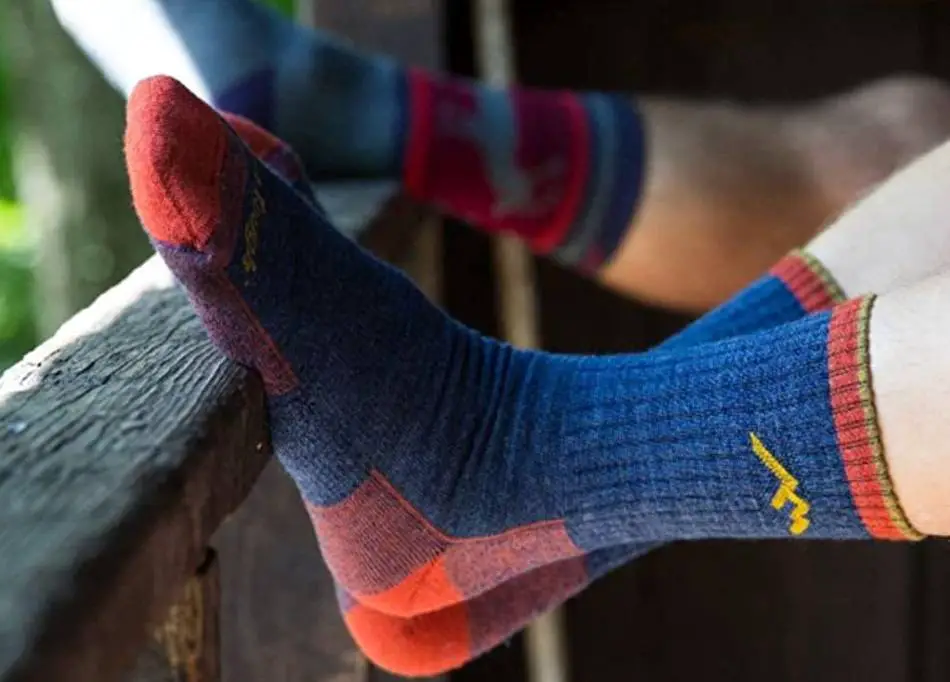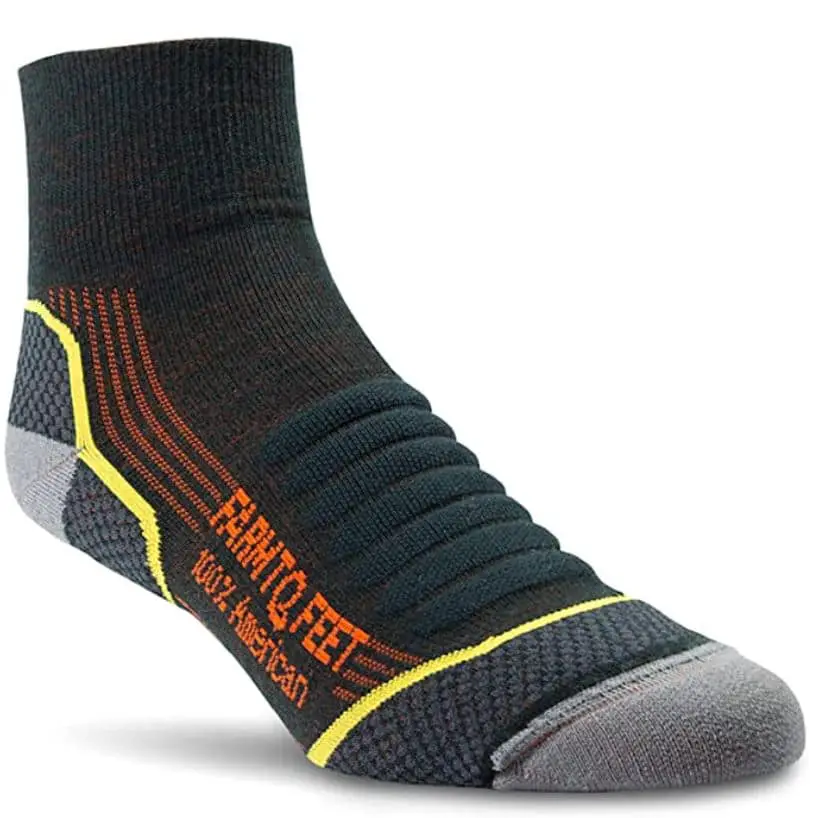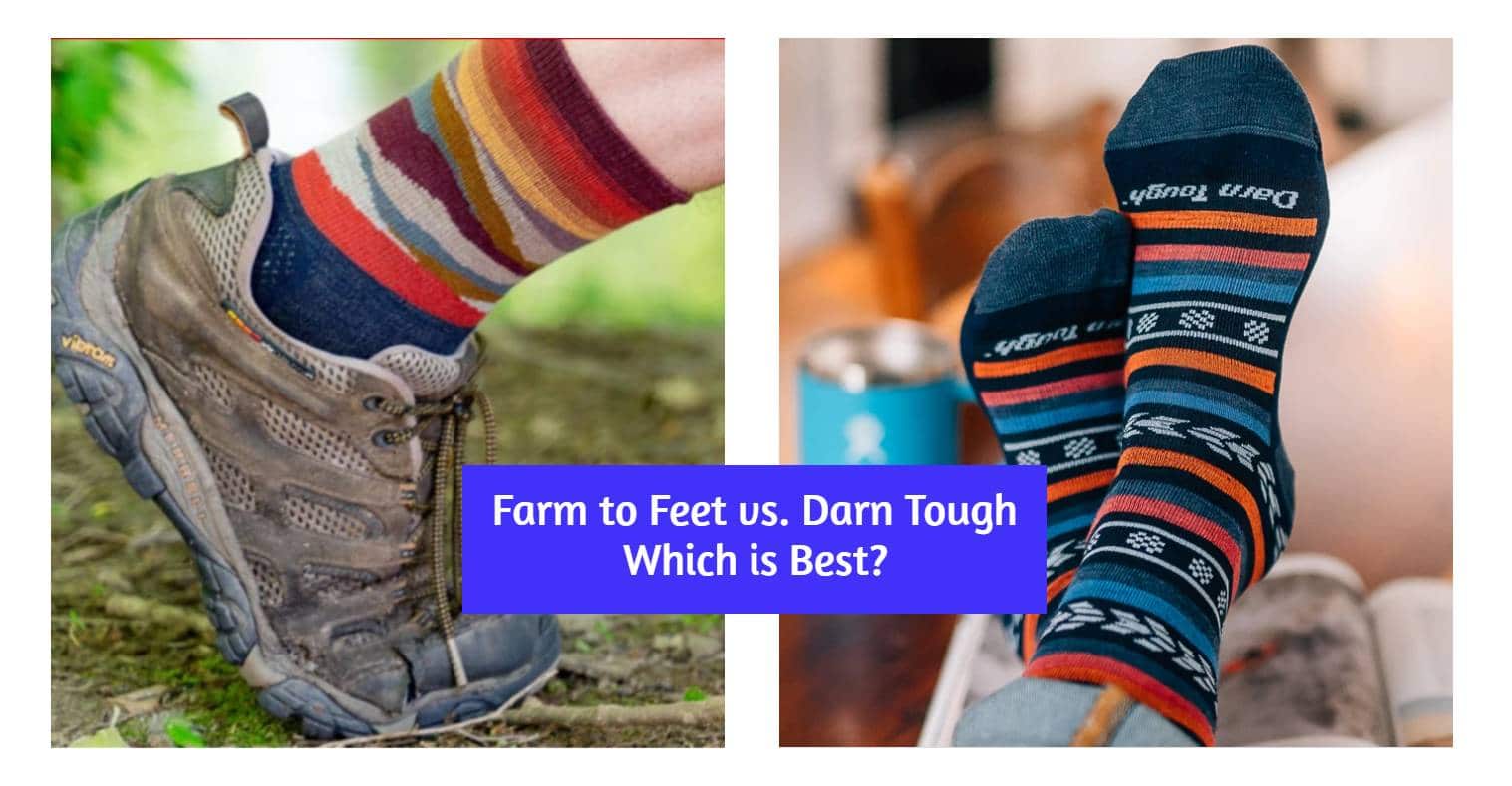When most people talk about hiking, the main focus of the topic orbits around the shoes. While they play a huge role in those kinds of activities, they don’t take all the credit.
Hiking shoes are primarily responsible for traction and keeping water from reaching your feet. What they cannot do is protect your feet’ skin. During a strenuous task like hiking, your feet endure a lot, and doing what with a lousy pair of socks is not advisable.
During the purchasing process of socks, the first order of business is to decide which brand to go for. The reason for this is because some brands are very good at producing excellent hiking socks. With the wide range of options available today, which one to go for?
Today I decided to do a comparison between two of the more popular socks brands – Farm to Feet and Darn Tough. I’ll dive into each company, outline what’s good and what’s bad, and give you my opinion on which one is better. Considering that I’ve owned several pairs of both, my goal is to provide an unbiased comparison.
| Brand: | Darn Tough | Farm to Feet |
|---|---|---|
 |  |
|
| Best For: | Over 75 Options, high-quality wool, quick drying | Unique and bright color options, excellent temperature regulation |
| Worst For: | Generic Designs | Less options to choose from overall |
| Comfort Level: | 9/10 - Very comfortable | 9/10 - Very comfortable |
| Material: | Variations of Merino Wool, Coolmax® Polyester, Nylon, and Spandex | Variations of wool and synthetic fibers |
| Warranty: | Lifetime Guarantee | Satisfaction guarantee and returned socks are recycled |
| Price Range | $14 to $30 | $15 to $24 |
Darn Tough
In the socks business, Darn Tough is a veteran with almost 4 decades of experience in the industry. This US-based socks company prides itself on its use of premium materials in its products.
It also manages to keep everything in-house, meaning that the products are made in their factory in Vermont.
In the socks business, Darn Tough is a veteran with almost 4 decades of experience in the industry. This US-based socks company prides itself on its use of premium materials in its products. It also manages to keep everything in-house, meaning that the products are made in their factory in Vermont.
Darn Tough is known for its wool-based socks, and it aims to be as animal-friendly as possible. The wool comes from a special type of sheep found only in America, which is only bred for that purpose. The aim is to have wool without hurting the animals.
Models and Options

In terms of design, considering the application of the socks, you shouldn’t expect something fancy. The designs are generally classic, with somewhat muted colors. In most cases, you are looking at box or stripe-like designs for most of the different cuts. There are a few with unique-ish patterns that have a great combination of colors.
To be honest, I’m not awed by the design, but then again, that is not a priority for me. One thing I really like is how well the branding is incorporated. Most manufacturers design the logo with the “in your face” technique, Darn Tough took a different approach. The branding is subtle but visible, and the color depends on the model you get.
Option-wise, Darn Tough doesn’t disappoint with its wide variety of models and color combinations. At this moment, there are 75 options for socks for men, women, and kids, including the pack options.
They vary in height, material, and design, and if you consider that most of them come in several color options, you are looking at plenty of options to choose from.
Materials
Darn Tough’s main selling point is the use of high-quality wool. They are typically made of Merino wool combined with synthetic materials such as Nylon and Spandex.
While wool is good, it’s a material that doesn’t cope well with higher temperatures. To fix that, Darn Tough has synthetic socks made with Coolmax polyester.
The advantage that this blend of materials provides is breathability and quick drying. For hiking socks, they need to be able to wick moisture from the feet, thus keeping them dry.
If the socks get wet, you can give them a quick wash and dry them reasonably quickly, unlike other materials.
Guarantee
When you pay a higher price for socks, you expect them to come with some kind of guarantee, which is the case with Darn Tough. The company offers a lifetime guarantee on everything you can get from them.
If you feel like the product doesn’t match your expectations, you can return it and get a refund. After that, the product will be recycled and used to produce a new set.
Price
When you go for premium socks, you should expect them to come with a higher price tag. When it comes to Darn Tough, the prices start from roughly $14 and go all the way up to $30 for a single pair of hiking socks. If you decide to purchase some of the packs, it will be cheaper compared to buying one pair at a time.
Farm to Feet

Compared to Darn Tough, Farm to Feet is an infant in the socks business. The company, as we know it today, was founded in 2013 in South Carolina.
An interesting fact is that Farm to Feet is a daughter company to Nester Hosiery which has been on the market for over 20 years. Some may remember the name as a socks manufacturer that had made products for professional use-cases such as rescuers or firefighters.
In terms of the products, it’s a similar story as with Darn Tough. You can go with wool-based socks, which are completely made in their factory. The material comes from locally-bread sheep. In addition to that, there are options for synthetic socks using materials made in America.
Models and Options
This is where you start to see some differences between both companies. Farm to Feet has some generic and classic designs for their models. Most of them come with some toned-down colors that don’t stand out too much from the crowd. On the other hand, there are several colorful options with brighter colors and some hiking-related graphics. People may be drawn a bit more towards this company in terms of design.
The branding situation is similar to Darn Tough. A discrete logo placed on the socks with a color that doesn’t burn your eyes is my idea of subtle. Combining this with the colorful options, I may lean a bit more towards Farm to Feet if the design is what I’m aiming for.
When it comes to options, the choice is not as extensive as I’d like it to be. There are 43 hiking models for men, women, and kids. There are various heights available, but most of them have only one or two color options.
There are only a handful of models that come with more color variations. It’s not terrible, and you won’t be stuck with some dull designs or no model offerings.
Materials
Farm to feet has a different approach when it comes to the materials used. The company basically blends wool with the choice of synthetic fabrics for optimal performance. As a result, around half of the material is wool for most of their models, and the rest is synthetic.
The resulting product is socks that have an excellent temperature regulation property and are soft and comfortable. On the other hand, the synthetic helps allow your feet to breathe and reduce the amount of moisture that the socks can absorb.
Guarantee
Purchasing socks from a premium brand means that you are expecting something more than just a pair of socks. Lucky for you, Farm to Feet is the type of company that has your back.
It offers a guarantee where you can return the socks if they don’t work for you for various reasons. The process is simple, and you are left with two options: get another pair of socks or get a refund.
Price
Price-wise, Farm to Feet is not the cheapest option you’ll find on the market. the lowest you can go for a pair of socks is $15, while the most expensive ones are $24.
This is not a huge price difference, but there’s one thing I feel like is lacking. Many other socks manufacturers have two or three-pack options where the price per pair is lower. Farm to Feet has a few packs, but there should be more.
Farm to Feet vs. Darn Tough – Which One to go for?
The answer to this question is a bit complicated, but I’ll try to explain why I’d go for one and not the other.
Farm to Feet and Darn Tough are both excellent brands, and you won’t make a mistake regardless of which one you go to. The deciding factor for me is the material of the stocks which is why I think Darn Tough is the best choice. Both sides use wool-based socks, but the blend of materials is what is essential. Darn Tough uses a higher concentration of wool which is excellent for regulating temperature.
On that, they add their Coolmax polyester that provides better breathing. Don’t get me wrong, Farm to Feet is not terrible in this department, but the combination of Darn Tough is just a bit better.
When it comes to pricing, Farm to Feet is slightly cheaper, but not by much. People that go for these kinds of socks may feel like they are saving a buck by going for Farm to Feet. Despite that, I believe that Darn Tough is worth paying a bit extra for what they can offer.
For the design, I’m not the person that chooses socks by color, but if I had to pick, I’d go for Farm to Feet. It has a bit more colorful options, even though the number of options is half of what Darn Tough has.
At the end of the day, I may give a subtle suggestion to get socks from Darn Tough, but I wouldn’t say to avoid Farm to Feet.
Choosing the right pair of socks
If you’re new to this, you probably have no idea where to start purchasing socks. In this section, I’ll outline a few key aspects to pay attention to when buying socks.
Material
This is one of the most important things to keep in mind. Hiking socks are usually made of a combination of materials where the manufacturer aims to provide the best performance possible. For example, wool is excellent at regulating temperature, polyester helps your feet breathe and reduces drying times, nylon is durable, and spandex is elastic. Combining these materials will result in excellent hiking socks – soft and durable that won’t hold in too much moisture.
Height and Weight
In terms of weight, you’d want to be as light on your feet as possible in hiking situations. For this, you’ll need to make a balance between weight and performance. Lighter socks don’t have thick cushioning as heaver socks. These won’t have as big of an impact on weight, but you may struggle in the comfort department.
On the other hand, heavier socks may slow you down a bit, but they are the opposite when it comes to features and comfort. The thicker padding and material mean that you are increasing the comfort for sure and prolonging the lifespan. Lighter socks are thinner, so you cannot expect them to last for many years, at least not as much as heavier socks.
Socks come in various height options, depending on your needs. They can range from socks below the ankles all the way up to your knees. In this regard, there is only one rule – your socks should be as high as the shoes you are wearing. The goal of the socks is to keep your skin completely separated from the inside of the shoes. If you get lower socks, you will expose part of your skin, leading to irritation.
Comfort
Uncomfortable socks on any occasion are a terrible idea, and for hiking, they are the worst. The lack of cushioning or crude material is a recipe for an awful hiking experience.
This is the reason why I recommend wool-based socks. It is a natural material that is soft and comfortable. On top of that, some socks models have additional cushioning on critical areas of your feet that take a lot of beating. Also, for hiking socks, it is essential to have a seamless toe. It will eliminate pressure or irritation on your toe in some extreme situations.
Durability
Last but not least is durability, part of which I touched on in a previous section. When hiking, you would want to have more durable socks. Going for those means that they will survive the trip and look forward to the next one.
You may think that you can get a new pair as soon as you feel that the socks start to give away. Yes, that is true, but you should consider that “letting go” can happen during hiking. Overall, as I mentioned, thicker socks with elastic and durable synthetic fibers are more durable than others.

